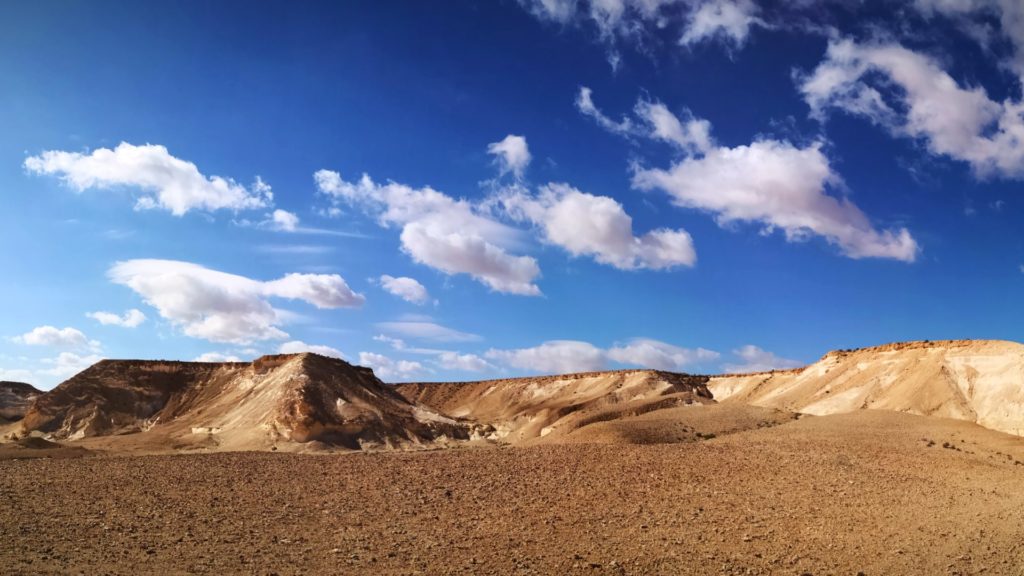Working on doing research for the post ‘Buried in the Sand – Hebrew as a Language of Desert People’ made me realize I had some huge misconceptions about two of the main pillar terms in the world of Dune and its mythology, and about the word ‘jump’ in Hebrew.
One of the terms – Kwisatz Haderach – which clearly derives from Hebrew, doesn’t quite mean what I thought it meant. The second term – Bene Gesserit – which I thought to have also derived from Hebrew, was in fact inspired by a different language.
Kwisatz Haderach
The term Kwisat Haderach is based on two Hebrew words. The first word is קְפִיצָה which is pronounced Qfitsa in Modern Hebrew. Here the letter Heh at the end of the word changes to Tav because it is the first word in a Smikhut compound. The second word is הַדֶּרֶך (HaDerekh) which simply means the (ה) road or way (דֶּרֶך).
The word קְפִיצָה (Qfitsa) is a noun. Its most basic and common meaning is a jump. For example, the track and field events Long Jump and High Jump are called in Hebrew קְפִיצָה לָרוֹחַק (Qfitsa LaRochaq) and קְפִיצָה לָגּוֹבַה (Qfitsa LaGovah) respectively. China’s Great Leap Forward is known in Hebrew as הַקְפִיצָה הַגְדוֹלָה קָדִימָה (HaQfitsa HaGdolah Qadimah).

For a long time, I thought the term קְפִיצָת הַדֶּרֶך (Qfitsat HaDerekh) meant exactly that – a great advancement literally and figuratively described as jumping over the road instead of walking the whole distance. But as it turns out, I was wrong about the literal meaning. Because here the word קְפִיצָה (Qfitsa) doesn’t mean jump, but rather what comes before the jump. Also, it refers to the road itself and not the person walking it.
The word קְפִיצָה (Qfitsah – jump) is based on the shoersh ק-פ-צ (Quf-Peh-Tsadi). From this shoresh we also get the verb קָפַץ (qafats) in Binyan Paal. This verb usually means to jump or to pop, but it can also mean flexing and tightening, which is an essential prerequisite of any from of jumping. A couple of good examples for using the shoresh ק-פ-צ in that sense are the word קָפוּץ (Qafuts) which means tightened or clenched, and the word קְפִיץ (Qfits) which means a spring – not the season but the coiled, bouncy object.
Therefore, the term קְפִיצָת הַדֶּרֶך (Qfitsat Haderekh) doesn’t describe a person jumping and covering more distance on a road, but rather the road miraculously tightening and the distance itself becoming shorter for the person walking it. According to Jewish Lore, this type of miracle is extremely rare and happened to three people only. One of them was Jacob the Patriarch when he journeyed to Harran in order to escape his brother Esau.
When I read the explanation about the actual meaning of קפיצת הדרך (Qfitsat HaDerekh) and how it describes the shortening of the distance itself in a metaphysical manner, it immediately reminded me the following scene from the movie Event Horizon:
I watched this movie only once, as a teenager not that long after it came out. I don’t remember much of it, but for some reason this particular scene has stuck with me for over 20 years. I guess it’s a combination of a very cool and complex concept delivered simply and perfectly by Sam Neill.
By the way, this demonstration also helped me notice another possible relation between several Hebrew root. The verb ‘fold’ in Hebrew is קִפֵּל (Qipel) which is based on the shoresh ק-פ-ל (Quf-Peh-Lamed) and it shares its two first letter with the shoresh ק-פ-צ (Quf-Peh-Tsadi), so it is quite possible they are related and derived from the same primal root ק-פ (Quf-Peh).
Another potential relative of these two, is the shoresh ק-פ-א (Quf-Peh-Alef) which means to freeze. Both roots ק-פ-צ (Quf-Peh-Tsadi) and ק-פ-א (Quf-Peh-Alef), and to a lesser extent also the root ק-פ-ל (Quf-Peh-Lamed) describe an object which was removed from its natural form or state and is now being sustained in a less stable state or a less “normal” from its perspective, either by force or via a shift in energy. The spring doesn’t want to remain pressed or stretched and waiting to be released, just the ice doesn’t want to stay frozen and waiting for the heat to thaw it back to water.

Another shoresh which is probably (more distantly) related to the shoresh ק-פ-צ (Quf-Peh-Tsadi), is the shoresh כ-ו-צ (Kaf-Vav-Tsadi) which express the meaning of getting smaller, shrinking, or contraction. Speaking of roots beginning with the letter Kaf, it also worth noting the phonetic resemblance between the root ק-פ-ל (Quf-Peh-Lamed) which means to fold and the root כ-פ-ל (Kaf-Peh-Lamed) which means to double or multiply. The origin of the shoresh כ-פ-ל may have been the primal root כ-פ which meant to bend, now expressed with the shoresh כ-פ-פ (Kaf-Peh-Peh).
Bene Gesserit
Turns out I was also wrong about the name of the secret order of Bene Gesserit. But this time it was totally not my fault, but the fault of the Hebrew translator who did his job just a little too well. You see, he translated their name to Hebrew as בְּנוֹת הַגִּשְׁרִית (Bnot HaGishrit) which can be interpreted as the Daughters of the Feminine Bridge. It is a very befitting name as not only do they serve as brokers and middlemen on many occasions, but also their endgame is to bring forth Kwisatz Haderach – a supreme human being who will help ascend the entire human race to a higher plain.
But Brian Herbert, the son of Dune’s author Frank Herbert believes the inspiration for the word Gesserit is the order of Catholic priests known as Jesuits. Considering Kwisatz Haderach is a messianic figure just like Jesus, and that it quite complements the word Bene which means good or well in Latin, it is a very fair and reasonable assessment. However, since he is not entirely sure of this, I think the “Daughters of the Feminine Bridge” is not an unreasonable alternative explanation.
Shai Hulud
When I first heard the name Shai Hulud, the giant sandworms of Arrakis, I was sure it had something to do with the Arabic word Sheikh (شيخ) – chief or tribe leader. I was wrong here too, though it is still Arabic. According to Dune Wiki it is شَيْء خُلُود which means a thing of eternity.
If I were to suggest a plausible Hebrew source of inspiration, I would go with שָׁי חוֹלוֹת (shai cholot) which means a gift (שי) of the sands (חולות). Phonetically speaking, it is not as strong a case as “Daughters of the Feminine Bridge”, but since these giant sandworms produce Spice – the most valuable substance in the universe – it is very compelling semantically, wouldn’t you say?
By the way, aren’t these giant sandworms a beautiful representation of chaos lurking under our feet? The fact they are attracted to and aggressively attack anything which produces a constant rhythm is just a great symbolism of the relation between order and chaos. Plus, it serves as a prefect reminder for us not to manifest too much order in your life, or chaos will come and devour your from beneath.
Jump Around
As jumping was the main theme of this post, let’s conclude it with the most מַקְפִיץ (Maqpits – makes you jump) song in Israel. It is called הָיְלָדִים קוֹפְצִים (HaYeladim Qoftsim) – The Children are Jumping.
You can see that as soon as people recognize the main riff of the song, they immediately get up and start jumping. The two lines repeating throughout the song are:
כל הילדים קופצים רוקדים
(kol hayeladim qoftsim roqdim)
מרימים את הידיים גבוה לשמיים
(merimim et hayada’im gavoha lashama’im)
The first line means all (כל) the kids (הילדים) are jumping (קופצים) and dancing (רוקדים), and the second line mean raising (מרימים) the hands (את הידיים) high (גבוה) to the skies (לשמיים).
Stay in Touch!
Get the next post from Hebrew Monk directly to you inbox!
Don't like emails? Subscribe to Heberw Monk's Telegram Channel instead.



